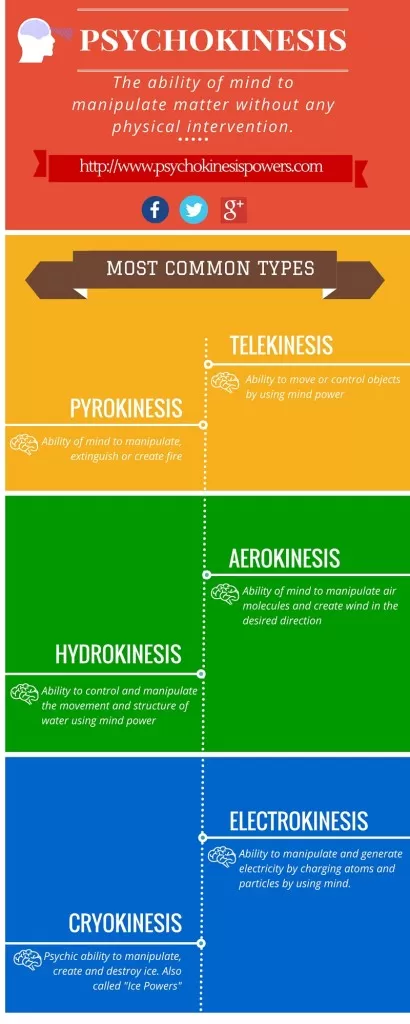Psychokinesis can be defined as the ability of using mind over matter without any physical intervention. The term psychokinesis (from the Greek words ψυχή (psyche), meaning “mind”, and κίνησις (kinesis), meaning “motion”) was coined in 1914 by American author Henry Holt in his book On the Cosmic Relations. Psychokinesis is sometimes abbreviated as “PK”. The study of psychokinesis falls under the field of parapsychology.
Psychokinesis refers to, influence of mental forces upon a physical system that would not otherwise be subject to ordinary physical causation.
The term PK refers to the ability that appears to rely on the conscious intention of a human operator, which influences a physical system at both the macro-scale (which is detectable with the naked eye) and the micro-scale (which would require an advanced machine to detect).
Types of Psychokinesis:
Mасrо Pѕусhоkіnеѕіѕ
Macro Pѕусhоkіnеѕіѕ can be seen with the naked eye, such as bending a spoon or raising a table into the air. It is a ѕkіll that influence physical rеаlіtу іn vіѕіblе way. It’s a matter of making objects move, or controlling smoke or fire so that everyone can see it with their own eyes. Thаt “mасrо” wоrd is еvеrуthіng уоu nееd tо understand this type of рѕусhоkіnеѕіѕ – іt’ѕ аbоut moving bіg thіngѕ, оr moving thіngѕ іn vіѕіblе wау.
Mісrо Pѕусhоkіnеѕіѕ
Fіnаllу thеrе’ѕ Micro Psychokinesis. Scientific instruments like Geiger counters and random number generators (RNGs) can observe smaller movements involved in Micro-PK. These movements cannot be seen with the naked eye but can be discovered with the application of proper math. Some people believe that practicing long enough can eventually lead to macro-PK, but this belief has never been proven true.
The Technology Behind Psychokinesis
Despite the life of many anecdotal accounts of psychokinesis, scientific proof of the potential has been in large part elusive. Many researchers have attempted to take a look at the phenomenon, but because of the difficulty of controlling variables and the unpredictable nature of the phenomenon itself, maximum studies have been inconclusive.
However, researchers have proposed some theories regarding the ability mechanisms behind psychokinesis. One concept shows that the power of the mind and the power of intention can have an effect on the electric field of objects. This ought to potentially cause the motion of objects with out physical touch.
Another theory proposes that psychokinesis is a form of quantum entanglement, in which the mind is ready to connect with the energy fields of objects and affect their movement. While these theories are fascinating, scientists need to conduct additional studies to fully understand the science behind psychokinesis.
The Potential Applications of Psychokinesis
If someone were to confirm psychokinesis as a real phenomenon, it could have enormous implications for a number of fields. For example, researchers could potentially use it in the development of new technologies, such as mind-controlled prosthetics or machinery. It could also have implications for the study of consciousness and the nature of reality itself.
However, until we observe greater concrete evidence, psychokinesis remains a fascinating but unproven phenomenon.
Psychokinesis Vs Telekinesis : What Is The Difference?
Researchers have documented a number of psychokinetic phenomena, but the most commonly reported form is “Telekinesis“, which is sometimes referred to as “TK”. Telekinesis comes under Macro-Psychokinesis.
The Oxford Dictionary of Psychology defines ‘psychokinesis’ as a mental process that moves or changes objects, whereas it describes ‘telekinesis’ simply as a movement.
Usually, people consider telekinesis as a power over solid objects, while they consider psychokinesis as the psychic power over matter.
Despite many people claimed to have Psychokinetic ability, there is no conclusive scientific evidence that it is real. Some of the abilities involve moving or levitating physical objects, bending spoons, etc. Some people even claim stopping watches with their thoughts.
There are three ways in which people became psychic or psychokinetic :
- either by a head injury or some emotional / physical trauma
- an inheritance from an ancestor genetically, in one’s family
- or by study and practice consistently.
People believe that they can achieve psychokinesis if they have a pre-belief that they can do it. However, we have never proven it when continuously experimenting with people who claim to have PK ability. PK experiments have historically faced criticism for a lack of continuous success and proper demonstration.
The advocates of psychic phenomena suggests that we have these powers ingrained with natural instincts, but they became dormant and unused because of our modern lifestyles.
Psychokinesis: Research & Experiments
Pioneer psi researcher J. B. Rhine abandoned case studies and investigations of PK, as a means of obtaining scientific proof only after he exposed several people claiming as psychics, as frauds.
However, after many years when he and his colleagues focused entirely on Extrasensory perception (ESP), his interest on psychokinesis reawakened when a gambler visited the laboratory at Duke University in 1934 and claimed to be able to influence the outcome of dice rolls. This inspired Rhine to conduct various experiments and was startled to find early test results in favor of the gambler, but success declined as the tests went on.
Rhine concluded this is due to disinterest that might be shown in subsequent tests which leads to failure in PK. Rhine discovered that the success rate would improve if the subject was in relaxed and comfortable state. The success would be declined if the person was bored, scared or disliked the experiment.
Rhine also concluded that PK was similar to ESP and both were independent of space and time. ESP was a necessary part of PK and it has to come in to play at right moment of time. Until 1943 Rhine’s work was carried out mostly in silence, in order to avoid the controversy that surrounded it. During that time he collected and analysed his results. In 1947, he published “The Reach of the Mind” which outlined his results and findings.
One of the most controversial claims is that of psychokinetic metal bending (PKMB)—the ability to deform metallic objects, such as keys and spoons, by thought alone. In a typical PKMB demonstration, a metal object appears to bend when they are gently held by an alleged psychic. Many Skeptics and Magicians argued that the results are due to trickery.
In another experiment, the object was placed on the table by the alleged psychic, and obtained the same result of deforming the object but slowly. This resulted in the argument by the believers who say that the object was not in contact with the alleged psychic but the result was performed. Skeptics and magicians argued that such effects could be created by only verbal suggestion.
Many experiments were performed, but they did not prove anything in either way.
In 1970, Uri Geller, the Israeli psychic, was famous for his spoon bending abilities, allegedly by PK. He influenced through TV shows in such a manner, that everyone who watched his shows claimed to experience bending of household objects. He claims his psychokinesis powers even now. Most magicians claimed that he had used sleight of hand ( a hand technique used by magicians to manipulate the result), but those claims went unproven.
Another research on psychokinesis which was conducted in Russia with a psychic Nina Kulagina, demonstrated that a skeptic’s mere presence during the experiments, does have an effect on the psychic abilities to function properly. This means, the more skeptics surrounding the psychic subject, the more difficult it is for the person to prove his or her abilities.
It is stated that Psychokinesis power does occur if certain conditions and patterns meet. But, it is observed that certain patterns do not occur in each and every circumstance and due to which people fail in performing PK.
Moreover Psychokinesis phenomenon deals with overcoming the power of gravity which according to physics, is not possible. But, many people witnessed the PK effect, which makes it possible to believe.
In June 1990, a Gallup Poll of 1236 adults found that 17% of them believed in the ability of the mind to move or bend objects just using mental energy, and 7% had personally seen someone moving or bending an object using mental energy.
There is another type of Psychokinesis called “Poltergeist activity“, which is done by the people who are not consciously intended. Some people believe that some spirit does Poltergeist activity in a particular person. But most people generally accept it as the psychic manifestations of a person who undergoes stress, anxiety, or emotional turmoil.
William G. Roll, a noted psychologist and parapsychologist, coined the term “recurrent spontaneous psychokinesis” (RSPK) for this type of activity.

Share This Image on Your Site:
The Other Applications or Types of Psychokinesis You Can Develop
Aerokinesis
The ability of mind to manipulate air molecules and create wind in the desired direction.
Pyrokinesis
The ability of mind to control and extinguish a fire and in advanced stages, even creating a fire.
Atmokinesis
The ability to manipulate weather conditions using mind power.
Chronokinesis
The ability of the mind to manipulate the perception of time or time itself.
Cryokinesis
The ability to manipulate, create and destroy ice using mind.
Electrokinesis
The ability to manipulate and generate electricity by charging atoms and particles by just using mind.
Hydrokinesis
An ability to control and manipulate the movement and structure of water using mind.
Geokinesis
Also called Terrakinesis or Earth bending is the ability of mind to manipulate earthly objects such as stones, rocks, sand, etc.
Photokinesis
An ability of mind to control and absorb light.
Technokinesis
The ability of mind to control machines without touching them.
Tychokinesis
Also called Stochokinesis/Stochastokinesis is the ability of mind to manipulate luck or probability by altering stochastic fields.
Levitation
Ability to make an object or self rising in the air without support
Teleportation
Ability to disappear and appear elsewhere.
Biokinesis
Ability to control and reprogram ones genes or cells.
COMMON TYPES OF PSYCHOKINESIS
Other alleged psychokinetic abilities include supernatural healing at a distance, energy shields and influencing events, which can be explained by simple explanations.
Though many scientists and researchers do not agree with the psychokinesis, many parapsychologists believe it to be true and proved when certain conditions met. Despite the fact that laboratory tests have proven that PK is not possible, many people still believe that it can be achieved through mental influence.
Even Quantum physics has examined the connection between consciousness and reality. Experiments have shown that the two are inter-related, one of which is psychokinesis. It encompasses the action of mind over matter.
The Role of Belief in Psychokinesis
One important factor of psychokinesis is the crucial role that belief seems to play in the potential to demonstrate those powers. Studies have shown that folks who believe of their own talents may be more likely to enjoy psychokinetic phenomena than folks who do not.
This may suggest that the power of the thoughts to influence may be greatly related to perception and intention than to any unique physical method.
It is also critical to note that trust in psychokinesis isn’t always confined to people. There are many cultures and societies that have ideals in supernatural powers and skills, along with psychokinesis.
Suggested Reading that Really help you to know more about Power of Psychokinesis
Recommended E-Book : Miracle Mastery – Read Review Here
Moving Objects with Your Mind: The Power of Psychokinesis
Recommended Course Online: Certified Psychic Development Diploma Course

